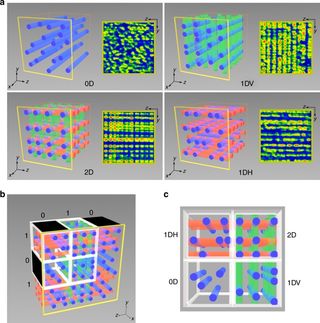Scientists Claim to Have Discovered Entirely New Form of Computing
The new technology uses soft polymer cubes and visible light instead of silicon.
Researchers have developed a new form of computing that uses the facets of a specially developed translucent polymer cube and visible light to perform addition and subtraction operations.

McMaster University’s graduate students — supervised by associate professor of chemistry and chemical biology Kalaichelvi Saravanamuttu — describe this new computing method in a paper published in the scientific journal Nature, that uses a soft polymer material that transforms from liquid to gel in reaction to the light. The scientists refer to this polymer as a “next-generation stimuli-responsive material that can compute” on its own.
To make it work, the researchers shine binary string of white light through the cube containing the operation they want to get solved. The materials internal properties then transform the beam input into one, two, or three white-light filaments ensembles that self-organize into periodic three-dimensional geometries that area the result of the operation, which are read by a camera sensor.
MORE: Best All-in-One Computers - Desktop PCs for Every Budget
How do these materials self-organize? I guess the answer must be magicks or, like they explain in their paper, the intrinsic nature of these new polymers. According to the scientists, these soft-polymer thin films, colloids, fluids, gels and solids open a path to amazing applications that go from enabling autonomous, low-power autonomous sensing — including tactile and vision — to artificial intelligence systems.

“When stimulated by electromagnetic, electrical, chemical or mechanical signals, these pliant polymer architectures transition between states while exhibiting discrete changes in physical or chemical properties that can be harnessed for biosensing, controlled drug delivery, tuning photonic band gaps, surface wettability and swelling,” the researchers say.
So what is the point of all of this?
Sign up to get the BEST of Tom’s Guide direct to your inbox.
Upgrade your life with a daily dose of the biggest tech news, lifestyle hacks and our curated analysis. Be the first to know about cutting-edge gadgets and the hottest deals.
“[T]he ultimate objective of this field is the biomimicry of intelligent responsiveness such as tactility, vision, camouflage, contractility and flight where complex natural sensors such as skin, eye and muscle seamlessly adapt to environmental stimuli through exquisitely programmed response sequences.”
While the scientists stress that they are not trying to compete with current silicon-based computing solutions, they are looking to increase the complexity of the operations they can perform. Talking to Eurekalert, paper co-author Fariha Mahmood said that they are ”trying to build materials with more intelligent, sophisticated responses."
According to Saravanamuttu, "we're very excited to be able to do addition and subtraction this way, and we are thinking of ways to do other computational functions."
Jesus Diaz founded the new Sploid for Gawker Media after seven years working at Gizmodo, where he helmed the lost-in-a-bar iPhone 4 story and wrote old angry man rants, among other things. He's a creative director, screenwriter, and producer at The Magic Sauce, and currently writes for Fast Company and Tom's Guide.

